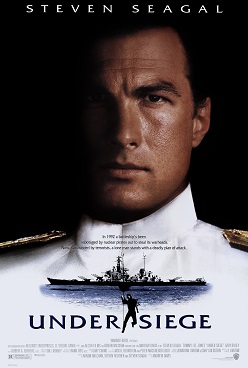
Under Siege is a 1992 American action thriller film directed by Andrew Davis, written by J. F. Lawton, and starring Steven Seagal as a former Navy SEAL who must intercept a group of mercenaries, led by Tommy Lee Jones, after they commandeer the U.S. Navy battleship Missouri.
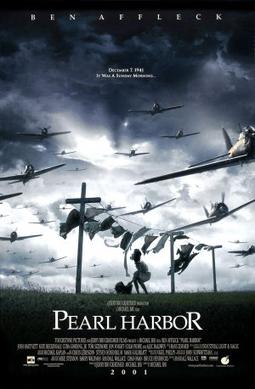
Pearl Harbor is a 2001 American romantic war drama film directed by Michael Bay, produced by Bay and Jerry Bruckheimer and written by Randall Wallace. It stars Ben Affleck, Kate Beckinsale, Josh Hartnett, Cuba Gooding Jr., Tom Sizemore, Jon Voight, Colm Feore, and Alec Baldwin. The film features a heavily fictionalized version of the attack on Pearl Harbor by Japanese forces on December 7, 1941, focusing on a love story set amidst the lead up to the attack, its aftermath, and the Doolittle Raid.

The Doolittle Raid, also known as Doolittle's Raid, as well as the Tokyo Raid, was an air raid on 18 April 1942 by the United States on the Japanese capital Tokyo and other places on Honshu during World War II. It was the first American air operation to strike the Japanese archipelago. Although the raid caused comparatively minor damage, it demonstrated that the Japanese mainland was vulnerable to American air attacks. It served as an initial retaliation for the December 7, 1941, attack on Pearl Harbor, and provided an important boost to American morale. The raid was planned by, led by, and named after Lieutenant Colonel James Doolittle. It was one of six American carrier raids against Japan and Japanese-held territories conducted in the first half of 1942.
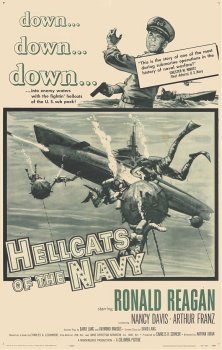
Hellcats of the Navy is a 1957 American black-and-white World War II submarine film drama from Columbia Pictures, produced by Charles H. Schneer and directed by Nathan Juran. The film stars Ronald Reagan and his wife, billed under her screen name Nancy Davis, and Arthur Franz. This was the only feature film in which the Reagans acted together, either before or after their 1952 marriage.

Richard Hetherington O'Kane was a United States Navy submarine commander in World War II, who was awarded the Medal of Honor for commanding USS Tang in the Pacific War against Japan to the most successful record of any United States submarine ever. He also received three Navy Crosses and three Silver Stars, for a total of seven awards of the United States military's three highest decorations for valor in combat. Before commanding Tang, O'Kane served in the highly successful USS Wahoo as executive officer and approach officer under noted Commander Dudley "Mush" Morton. In his ten combat patrols, five in Wahoo and five commanding Tang, O'Kane participated in more successful attacks on Japanese shipping than any other submarine officer during the war.

Charles Bowers Momsen, nicknamed "Swede", was born in Flushing, New York. He was an American pioneer in submarine rescue for the United States Navy, and he invented the underwater escape device later called the "Momsen lung", for which he received the Navy Distinguished Service Medal in 1929. In May 1939, Momsen directed the rescue of the crew of Squalus (SS-192).

The submarine film is a subgenre of war film in which most of the plot revolves around a submarine below the ocean's surface. Films of this subgenre typically focus on a small but determined crew of submariners battling against enemy submarines or submarine-hunter ships, or against other problems ranging from disputes amongst the crew, threats of mutiny, life-threatening mechanical breakdowns, or the daily difficulties of living on a submarine.

Operation Petticoat is a 1959 American World War II submarine comedy film in Eastmancolor from Universal-International, produced by Robert Arthur, directed by Blake Edwards, and starring Cary Grant and Tony Curtis.

I-400 was an Imperial Japanese Navy Sentoku-type submarine commissioned in 1944 for service in World War II. Capable of carrying three two-seat Aichi M6A1 "Seiran" float-equipped torpedo bombers, the Sentoku-class submarines were built to launch a surprise air strike against the Panama Canal. Until 1965, the Sentaku-type submarines—I-400 and her sister ships I-401 and I-402 —were the largest submarines ever commissioned.

The Fighting Seabees is a 1944 American war film directed by Edward Ludwig and starring John Wayne and Susan Hayward. The supporting cast includes Dennis O'Keefe, William Frawley, Leonid Kinsky, Addison Richards and Grant Withers. The Fighting Seabees portrays a heavily fictionalized account of the dilemma that led to the creation of the U.S. Navy's "Seabees" in World War II. At the 17th Academy Awards, the film received a nomination for Best Scoring of a Dramatic or Comedy Picture for Walter Scharf and Roy Webb but the award went to Max Steiner for Since You Went Away.
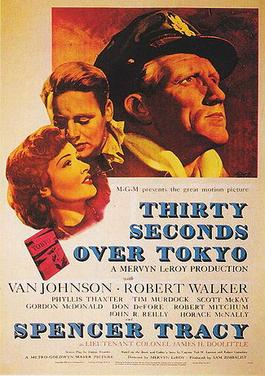
Thirty Seconds Over Tokyo is a 1944 American war film produced by Metro-Goldwyn-Mayer. The screenplay by Dalton Trumbo is based on the 1943 book of the same name by Captain Ted W. Lawson. Lawson was a pilot on the historic Doolittle Raid, America's first retaliatory air strike against Japan, four months after the December 7, 1941, Japanese attack on Pearl Harbor. The raid was planned, led by, and named after United States Army Air Forces Lieutenant Colonel James Doolittle, who was promoted two ranks, to Brigadier General, the day after the raid.
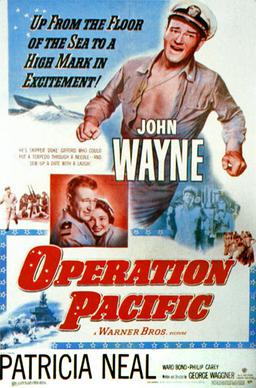
Operation Pacific is a 1951 black-and-white World War II submarine war drama from Warner Bros. Pictures, produced by Louis Edelman, and written as well as directed by George Waggner. John Wayne and Patricia Neal star and Ward Bond and Philip Carey play supporting roles.

Crash Dive is a World War II film in Technicolor released in 1943. It was directed by Archie Mayo, written by Jo Swerling, and starred Tyrone Power, Dana Andrews, and Anne Baxter. The film was the last for Power before assignment to recruit training, as he had already enlisted in the United States Marine Corps.

Gray Lady Down is a 1978 American submarine disaster film directed by David Greene and starring Charlton Heston, David Carradine, Stacy Keach, Ned Beatty, Ronny Cox and Rosemary Forsyth, and includes the feature film debut of Michael O'Keefe and Christopher Reeve. It is based on David Lavallee's 1971 novel Event 1000.

The Hunt for Red October is a 1990 American submarine spy thriller film directed by John McTiernan, produced by Mace Neufeld, and starring Sean Connery, Alec Baldwin, Scott Glenn, James Earl Jones, and Sam Neill. The film is an adaptation of Tom Clancy's 1984 bestselling novel of the same name. It is the first installment of the film series with the protagonist Jack Ryan.

Lt. Robin Crusoe U.S.N. is a 1966 American comedy film released and Walt Disney Productions, and starring Dick Van Dyke as a U.S. Navy pilot who becomes a castaway on a tropical island. Some filming took place in San Diego, while a majority of the film was shot on Kauai, Hawaii.

Torpedo Run is a 1958 American war film directed by Joseph Pevney and starring Glenn Ford as a World War II submarine commander in the Pacific who is obsessed with sinking a particular Japanese aircraft carrier. The film's working title was Hell Below. It was filmed in CinemaScope and Metrocolor.

I-14 was an Imperial Japanese Navy Type AM submarine that served during World War II. Designed as a submarine aircraft carrier, she was commissioned in March 1945. She surrendered in August 1945 and was sunk as a target in 1946.

Run Silent, Run Deep is a 1958 American black-and-white war film starring Clark Gable and Burt Lancaster, based on the 1955 novel of the same name by Commander Edward L. Beach Jr. The picture was directed by Robert Wise and produced by Harold Hecht. The title refers to "silent running", a submarine stealth tactic. The story describes World War II submarine warfare in the Pacific Ocean, and deals with themes of vengeance, endurance, courage, loyalty, and honor, and how these can be tested during wartime.
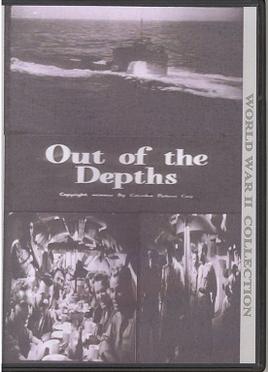
Out of the Depths is a 1945 American war drama film directed by D. Ross Lederman.





















